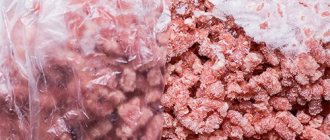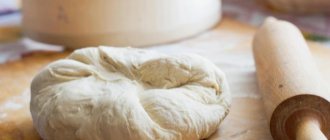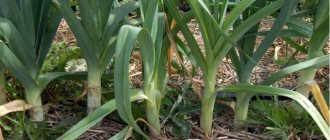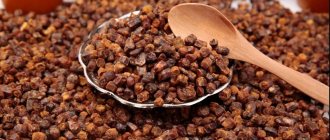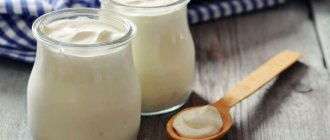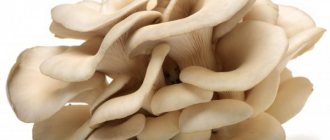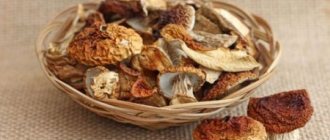Oyster mushrooms are a common ingredient and can be found in many recipes. They are used to make fragrant soups, fried with meat, and added to salads and omelettes. In order to please yourself and your loved ones with delicious mushroom dishes throughout the long winter, you need to make supplies in advance. How and for how long should oyster mushrooms be stored at home in order to preserve the taste and aroma they contain? We will tell you about this now.
Preparation
Optimal storage conditions for oyster mushrooms are temperature from +2 to +10 °C, good ventilation and free distribution in prepared containers. But special attention should be paid to preparing mushrooms for storage. First of all, they need to be cleaned properly. Otherwise, the mushrooms will become watery and lose their nutrients.
Considering that oyster mushrooms grow on trees, there is practically no dirt on them. Therefore, they do not need to be soaked. Sort through the mushrooms, remove any wormy or spoiled ones. Even minor damage can cause damage to all neighboring mushrooms. Divide the oyster mushrooms into small piles. Place each of them in a colander and rinse under strong running water. Place the washed pieces on a board or plate and dry slightly. Further actions will depend on which storage method you prefer and for what dishes the mushrooms will be used.
Oyster mushrooms: description and photo
Oyster mushroom or, as it is popularly called, oyster mushroom, is an edible mushroom of the oyster family. It is widespread in temperate forests. It grows in groups on stumps, dead wood and trunks of deciduous trees. Their number in a group can be 30 or more fruiting bodies, which grow together at the base, representing a kind of “bouquet”.
The fungus itself is a pest for trees, as it causes yellow rot in them. The more rot that forms, the more oyster mushrooms can be found in that area. If a tree dies due to infection, they can continue to grow on it, which is why this fungus is considered to be predatory.
Oyster mushroom is edible and does not pose a threat to the human body; it also has no resemblance to poisonous species.
The specimens grow large, the diameter of the cap can reach 10 cm. It feels dense, fleshy, has a thin edge, and the general shape is round. Age can be determined by the shape of the cap - if it is convex, then the mushroom is young, and if it is flat, then it is old. The color can vary from yellowish to ashy with a purple tint.
The leg is usually short. Often you may not even notice it under a large hat. The pulp is juicy, white and dense. Over time, it becomes tougher and more fibrous. It has practically no smell. The taste, according to many reviews, is soft and pleasant. May resemble anise. This is due to the benzaldehyde content in the chemical composition.
Did you know? In terms of protein content, oyster mushrooms can be compared to dairy products or meat. This figure is 2.5 g per 100 g.
In a refrigerator
Mushrooms belong to the category of perishable products. Therefore, you can store oyster mushrooms in the refrigerator only if you eat them within 72 hours. Due to the large amount of beneficial minerals, vitamins A and E contained in oyster mushrooms, some mushroom lovers prefer to eat them raw. There are no contraindications to this method of use.
If you decide to keep supplies in a plastic bag, place the mushrooms in it in one layer, release all the air and tie the edges tightly
You can store oyster mushrooms in the refrigerator in plastic containers and plastic bags. When using containers, try to arrange the mushrooms in even layers. The height of the packaging should not exceed 25 cm. To protect the workpiece from drying out, cover the container with cling film. It will retain moisture inside the container, and the mushrooms will retain their appetizing appearance throughout their shelf life.
If you decide to keep supplies in a plastic bag, place the mushrooms in it in one layer, release all the air and tie the edges tightly.
Basic rules for storing oyster mushrooms at home
Fresh, store-bought hangers can be kept in the refrigerator for no more than 3 days. Leaving them at room temperature is not a good idea. If processing is not planned before storage and the mushrooms are needed fresh, they should not be washed, much less soaked. This is due to the fact that their structure is porous and, like a sponge, it absorbs water. There are microbes in the liquid, it turns sour and fungus develops.
To avoid spoilage of the product, oyster mushrooms are carefully washed under running water, but not immersed in it. If the mushroom is externally clean, it is permissible to simply wipe it with a damp sponge. To remove residual moisture, place it on a dry towel, and after a couple of hours put it in the refrigerator. But it is not necessary to wash it before sending it to the chamber; just put it in a wide bowl and cover with cling film or napkins.
Attention! You can extend the shelf life of oyster mushrooms in the refrigerator if you first wrap them in dry, thin paper (tracing paper). They will stay like this for 7-10 days.
Post-harvest processing
Fruiting bodies need to be processed faster because they are perishable products. The process of their processing includes the following stages:
- Removing damaged elements - screening. From their total mass, damaged, rotten, wormy, rotten fruiting bodies must be removed. It is worth carefully inspecting the oyster mushrooms for mold. All spoiled mushrooms are dangerous for a good harvest - they will cause it to rot.
- Sorting. Depending on the size, the fruiting bodies are placed in separate containers, based on the method of subsequent processing. Small mushrooms are used for preservation, while large ones are processed, stewed, boiled or fried.
- Cleaning. Debris, sand and traces of insects are removed from the surface of each. Use a sponge, knife or hard brush. Small darkening areas are cut out.
- Fruiting bodies intended for processing are washed immediately. If they need to be dried or frozen, this step is omitted.
If you follow all the described recommendations, the collected oyster mushrooms will be well stored. These mushrooms grow in massive groups. If you need to dry it, you should first divide them into separate elements, this will make the process go faster. For freezing, the fruiting bodies are cut into small pieces and packaged in portions.
Preparation for storage
If the harvested crop is planned to be stored for a long time, it is not washed. Mushrooms that are too dirty can only be rinsed under running water. After this, dry them well by placing them on a paper towel. Store them in the refrigerator or freezer separately from other products due to their inherent ability to absorb all foreign odors.
If the bag or container is left open, the mushrooms will quickly become weathered and may dry out. During storage, they can release moisture and deteriorate from it, so the bottom of the container should be lined with a paper towel or napkins. It is better to lay the fruiting bodies in one layer, otherwise they may become wrinkled.
In the freezer
For long-term storage, freezing is best. This is the most practical and widespread way of harvesting oyster mushrooms, in which their beneficial properties and qualities can be preserved for 1 year. Be sure to ensure that all mushrooms are whole and undamaged.
Slightly spoiled and broken oyster mushrooms can be frozen only after boiling. To do this, cut them into pieces, put them in boiling water and boil for about 5 minutes. Drain in a colander and cool. Transfer to containers and store in the freezer.
Some housewives prefer to freeze fried or oven-baked oyster mushrooms. If you are a supporter of this storage method, try to use a minimum amount of oil and heat treat the mushrooms until the water completely evaporates.
Read also: How to properly store mushrooms?
Features of champignon storage
How to wash bio-down in a machine and by hand?
Freezing Recommendations
The freezing method has several differences from storing in the refrigerator. If you place oyster mushrooms in the freezer fresh, then if the procedure is carried out correctly, they will be able to retain their taste and beneficial properties for 5 months. And if you boil them first, the shelf life will be longer. The main task is the correct temperature regime in the freezer and proper preliminary preparation.
To freeze boiled oyster mushrooms you need:
- Inspect the mushrooms and remove any damaged ones. Selected good specimens are washed under running water. Large ones should be cut. After washing, the product is placed in a pan and cooked for 15 minutes in salted water.
- Then the water is drained, the finished product is cooled, the excess liquid is slightly drained, it is allowed to cool, squeezed out (to get rid of excess liquid), and then laid out in plastic containers or plastic bags. Packaged mushrooms are sent to the freezer. The storage period can be up to 8 months.
To freeze fresh oyster mushrooms, follow these instructions:
- It is better not to wash the mushrooms, but to dry them to remove dust and debris and remove damaged ones. Whole ones need to have their stems cut off.
- Prepared mushrooms are laid out in one layer on a tray or plate and placed in the freezer for several hours.
- After freezing, package in portions.
The shelf life in this way can be up to 12 months. But remember that mushrooms cannot be re-frozen and the temperature in the freezer must be at least (-18) degrees.
Drying
You can dry mushrooms in the fresh air, in the oven, or by combining both methods. It is better to dehydrate oyster mushrooms according to the scheme presented below.
- Place the washed and peeled mushrooms on a baking sheet and dry at a temperature not exceeding +50 °C for about 8 hours.
- After the specified period, place the dried preparations in a ventilated area for 1–2 days. Make sure that the mushrooms are well ventilated, otherwise they will spoil.
- Place the oyster mushrooms again in the oven to dry for 6 hours at +70 °C.
- Check the condition of the mushrooms. If they break, they are ready. If necessary, dry the workpieces at a temperature of +50 °C.
Heat-treated mushrooms should be stored in airtight containers with tight lids. Glass jars are best suited for these purposes. Use dried preparations for cooking throughout the year. If stored for a longer period of time, they lose nutritional value and are harmful to health.
You can make mushroom powder from dried oyster mushrooms. To do this, grind the preparations in a mortar or spice grinder. Store powder in a dry, dark, cool place in an airtight container.
Drying method
If the methods discussed above do not meet your requirements, pay attention to a method that does not require financial costs and the constant presence of working household appliances - drying. Dry fruit bodies retain the beneficial properties of the delicacy and can also be used in absolutely any area of cooking. In order to return the mushroom to its original appearance and size, it is necessary to soak the dried specimen in water or cream for approximately 60-90 minutes.
It is worth noting that it is dried mushrooms that retain all nutrients and minerals, while other heat treatment reduces the amount of useful elements in the product.
So let's get started with the process:
- Prepare the necessary available tools: a cutting board, paper or newspapers, a skein of strong thread with a gypsy needle (can be replaced with wire or thin fishing line), napkins, a large piece of dense material, a sharp knife.
- Take the amount of dry mushrooms required for preparation. Do not wash or wet the product under any circumstances.
- Using a sharp knife and dry wipes, scrape off soil, leaves and debris from the caps, and separate the “heads” from the stems. Gently wipe each fruit with napkins or cloth, then place it on a newspaper laid out in advance. It is important that the mushrooms lie tightly to each other, but do not touch.
- Move the newspaper to a well-ventilated place, preferably in direct sunlight. Strictly avoid rooms with dampness, as the mushrooms will not dry, but spoil. Leave for 3-4 hours.
- Now you will need a thread with a needle (or wire). The next stage is stringing the fruiting bodies onto “beads”. If you don’t know what a bunch of mushrooms should look like, turn to the Internet for help - the network contains thousands of examples of the “design” we need.
- After the stringing process is completed, tie the ends of the thread or connect the wire, and then hang the treat in a warm place - next to the radiator or over the stove. In the first case, it may take several days for high-quality drying, in the second – no more than 12-14 hours.
- After the specified time has passed, check the readiness of the supplies: try to bend the oyster mushroom, if it gives in and bends gently, the dry mushroom is ready. If it breaks, continue drying.
Once the drying process is complete, take care of a container designed to store supplies. These can be glass jars with lids, food containers or thick paper bags. Pack the product into containers and leave it in a dry place.
The shelf life of the treat is 10-12 months.
Salting
Pickling oyster mushrooms is another way to store mushrooms at home. Salting can be hot or cold. With the cold method, peeled and washed oyster mushrooms are soaked in a salty solution for 2–6 days. A prerequisite: the water must be changed every day, otherwise the mushrooms will become bitter. The hot method differs in that the mushrooms are not soaked, but boiled in salt water for about 15 minutes. After salting, transfer the oyster mushrooms to barrels or glass jars and store at a temperature of 0 to +8 °C.
How to choose the right mushrooms for freezing
Before putting oyster mushrooms in the freezer, you need to carefully select suitable mushrooms .
- At the time of purchase, you should inspect the product for yellow spots on the cap. If this occurs, then the mushrooms are not suitable for freezing, since during the cooking process their taste and smell will not be the most pleasant.
- It is also recommended to pay attention to the smell of mushrooms, which will be the most reliable indicator of their freshness. If there is a strong, unpleasant aroma, you should not buy the product.
- You also need to pay attention to the presence of cracks on the caps. If they are, then this will also indicate that the specimens are not fresh.
- The legs of oyster mushrooms contain a very small amount of useful elements; moreover, they are tasteless and most often hard. So you need to pay attention to how well the mushrooms were trimmed. The legs of high-quality oyster mushrooms should either be completely cut off or be very short.
- The age of an oyster mushroom can be determined by the size of its cap. Overgrown mushrooms are not as beneficial for the human body as young ones; moreover, they usually have insipid, fibrous flesh, which becomes almost “rubbery” after cooking. It is better to buy young mushrooms, which contain more vitamins. These oyster mushrooms are juicy and soft, and their flesh is white.
Pickling
To marinate mushrooms, you will need a large saucepan, rolling jars, acetic acid, salt, pepper and spices to taste. There are two methods of pickling. Some housewives prefer to first prepare the marinade, then boil the mushrooms in it. Others boil mushrooms in salted water and then pour marinade over them. The choice is yours. Just keep in mind that in the first case, jars of mushrooms have a shelf life of up to 12 months, and in the second, the shelf life is reduced by almost 2 times.
Now you know how and how long to store oyster mushrooms at home. Whatever storage method you choose, pay special attention to the condition of the mushroom caps. The more intact they are, the better the workpieces are preserved.
How to store oyster mushrooms
In order to ensure that the mushroom supply in the house does not dry out, and that a tasty delicacy is always present on the table, it is necessary to properly prepare fresh oyster mushrooms for storage, and then adhere to a certain technology. We present to your attention the main stages, subject to which access to the fruiting bodies of the crop we are considering will be long, even year-round.
Examination
Once you have collected oyster mushrooms yourself or purchased them at the market, it is important to ensure the quality of the product. When the fruits are spoiled, any further manipulation will be pointless, so first of all it is recommended to conduct a visual inspection of the crop, as well as evaluate the aroma emitted by the fruits. Edible, fresh mushrooms are distinguished by dense, light flesh and a bright mushroom smell (without any acid or mustiness).
Harvest cleaning
Once there is no doubt about the quality of the product, it is necessary to clean it well. A common mistake made by many inexperienced foragers is soaking mushrooms for a long time in cold water and actively “floundering” in the liquid. In fact, it is enough to immerse the oyster mushrooms in a container filled with water, collect the floating debris with your hand, and pour over the caps with a cool shower. Otherwise, the crop will become watery and possibly damaged. Since the culture develops on tree trunks, soil and other difficult-to-wash-out debris are rarely found on it, which means that all excess can be removed without problems.
After wet cleaning, it is important to examine each mushroom for damage, worms or rot. Some people switch the “steps”, first sorting and then washing the crop - this is exactly the case when the sum does not change from changing the terms.
Remember, even one spoiled member of the family can cause damage to the entire stock.
After completing the described manipulations, the oyster mushrooms are placed on a wire rack, cloth or sieve to get rid of excess moisture. Further actions depend on the planned storage method, because fruiting bodies can be boiled, frozen, salted, pickled, dried, etc.
Benefits and harms of the product
Oyster mushrooms are very nutritious and tasty. Their nutritional value when stewed is 70 kcal, and when raw it is 40 per 100 grams of product. They satisfy hunger well, but are low in calories.
These mushrooms have a number of medicinal properties. They can be used for prevention and as a dietary supplement in the following cases:
- Reduce the risk of cardiovascular diseases and normalize blood pressure.
- They have a cleansing effect and remove toxins and waste from the body.
- Remove heavy metals and neutralize the effects of radiation.
- They reduce the risk of strokes and thrombosis, and also dissolve bad cholesterol and cleanse blood vessels of it.
- Normalize metabolic processes in the body.
- Prevents the development of atherosclerosis.
- Strengthens the nervous system.
- They reduce the likelihood of developing gastritis and ulcers, improve the passage and digestion of food, and also have a beneficial effect on intestinal activity.
- Increases the body's ability to absorb calcium.
- Prevents the development of malignant neoplasms and cell mutations, fights cancer.
- Thanks to the content of riboflavin, vision improves.
In addition, it is worth noting that in 1997, Japanese doctors proved that oyster mushrooms help cure a number of cancer diseases. Of course, these mushrooms are not a panacea, but this fact is worth paying attention to.
But despite all their advantages, there are also disadvantages that need to be taken into account:
- Mushrooms contain a high level of chitin, which is poorly absorbed and digested by the body.
- It is for better digestibility that they should be processed at high temperatures (fry, boil or stew). This will increase digestibility by approximately 60−70%.
- It is not recommended for use by people with acute diseases of the liver, gall bladder and gastrointestinal tract disorders.
- The sources of poison are spoiled mushrooms. Therefore, before use, it is necessary to carefully examine each mushroom and throw away the spoiled ones.
- Pregnant women and children under 12 years of age are prohibited from consuming mushrooms.
No one will dispute the benefits and nutritional value of oyster mushrooms for the human body. These mushrooms contain a large amount of amino acids, proteins, fats, carbohydrates, vitamins B, C, E. They can remove heavy metal salts, as well as radionuclides, from the intestines.
Oyster mushrooms are considered one of the most popular mushrooms. Quite varied and healthy dishes are prepared from them. Our grandmothers also successfully used processes that made delicious mushroom preparations. If we talk about oyster mushrooms, they were dried, boiled, stewed, fried, fermented and pickled for the winter. Today, similar procedures are also widely used among most Russian families. In addition, freezing has recently become a popular option for preparing mushrooms. And the age of high technology makes it possible to prepare mushrooms for future use, while preserving their freshness and aroma.
Oyster mushrooms can not only be collected in the forest, but also simply bought in a store at an affordable price. In addition, these fruiting bodies are considered not only a delicious product, but also a dietary one. It must be admitted that the taste of oyster mushrooms differs from other mushrooms and is very similar to the taste of chicken meat.

